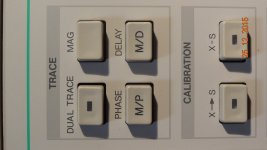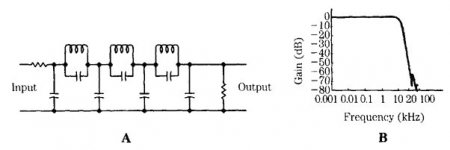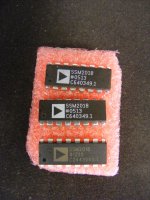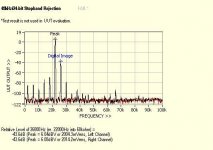Wilbraham predates Gibbs! Who knew?
http://www.math.umn.edu/~garrett/m/mfms/notes_2013-14/04a_Wilbraham-Gibbs.pdf
Like many things in which the more famous person's exposition gets his or her name attached.
http://www.math.umn.edu/~garrett/m/mfms/notes_2013-14/04a_Wilbraham-Gibbs.pdf
Like many things in which the more famous person's exposition gets his or her name attached.
George, the OFFICIAL calender in Serbia is midnight of December 31 for the old year to be changed to new, always has been since 1918. So, rest assured on that night there will be a lot drunk and singing Serbs, I would guess like 95+% of the population. But traditions die hard, so we'll repeat it all again some two weeks later. Some true enthusisasts will have a third go in late January, when it's the Chinese new year.😀 Just for the sake of good international relations, you understand.😀 Peace, brother!😀
Richard
I was confused from the beginning when you said that HF limiting the output of the DAC for to reduce the out of band noise, reduces at the same time the sqw waviness as well.
The opposite is true regarding sqw waviness. The more HF limiting we apply at the DAC output, the less out of band noise comes out of course but then and due to HF limiting, the more waviness is observed on the square wave tops & bottoms. This is the Gibbs phenomenon
George
This deserves an answere..... A partial one, at least ..... I was only changing the rise time of the generator transient edge. There was no ringing on the generators' square wave when changing the rise time (Tr). The faster the Tr, the more "Gibbs" ringing showed on output.
Since the internal computations/math is complex, i would not venture to guess what slope is best for everyone. Best done by the mfr for their machine.
And, some/many do it but does it have low enough GD?
As far as I am concerned, it must be Bessel or similar for best GD and considering the processes own filter and what it does... maybe correction as well to get GD low enough.
I started looking into GD ever since Dean Jensen told me he designed all his transformers for flat GD response characteristics.... it was the key to its good sound over others.
I can tell that because he isnt with us any more. It was one small step for mankind. But what do the digital guys do when they filter/process? Did anyone tell them to make flat and very low GD filters? I don't think so. And, if they couldnt make a filter that was not audible, better to have little or no filtering and let go wide open?? Well, what ever one decides, you have no excuse today for not being able to make an audibly transparent LPF filter. Right?
THx-RNMarsh
Last edited:
Yes, that's after 1968. At least in the number system I use.
Really and it just seemed you wanted to be demeaning. Oh you still are..
This deserves an answer..... A partial one, at least ..... I was only changing the rise time of the generator transient edge. There was no ringing on the generators' square wave when changing the rise time (Tr). The faster the Tr, the more "Gibbs" ringing showed on output.
Thank You
Yes, Shorter rise time means increasing the bandwidth (more HF content) of the signal.
The signal generator has no LP filter at it’s output, nor the input of your measuring instruments, so they don’t show any waviness.
But when that richer in HF content SQR wave signal is to be reproduced by the legitimate bandlimited CD player it will display more waviness compared to the less steep SQW wave
As far as I am concerned, it must be Bessel or similar for best GD and considering the processes own filter and what it does... maybe correction as well to get GD low enough.
…
Well Richard
I test myself for GD issues at low frequencies for a long time now and I find I am not sensitive at all to the effect.
Recently I visited this site:
blogohl: Phase audibility
Doing the tests not only with the signal generator but processing music files (.wav) through it, I confirmed my deafness to GD effect at mid to high frequencies as well.
So, I am not the appropriate person to comment on this.
Well, what ever one decides, you have no excuse today for not being able to make an audibly transparent LPF filter. Right?
I can’t be that optimistic as you on this, even if my hearing was better than it is.
But as you know, less GD means less steep filter slope, so no free lunch.
George
I think I found and explained a good way to find the best compromise for filter cut-off with a given recorder/player.
I do not know how many people out there can measure GD or design GD correction filters. But the results i hear is promising and worthwhile.
A DIY variable group delay equalizer would be nice to see. I used such equipment with the military to condition data lines. Wish there were some consumer PRO versions today.
THx-Richard
I do not know how many people out there can measure GD or design GD correction filters. But the results i hear is promising and worthwhile.
A DIY variable group delay equalizer would be nice to see. I used such equipment with the military to condition data lines. Wish there were some consumer PRO versions today.
THx-Richard
Last edited:
Just for Scott,
I got my Chinese SSM2018 chips in today. They do not appear to be fakes, they look like 10 year old pulls that have had the leads re-tinned.
Shown is one from Rochester and the two from UTSource China.
I got my Chinese SSM2018 chips in today. They do not appear to be fakes, they look like 10 year old pulls that have had the leads re-tinned.
Shown is one from Rochester and the two from UTSource China.
Attachments
Last edited:
I do not know how many people out there can measure GD or design GD correction filters. But the results i hear is promising and worthwhile.
THx-Richard
This would be a good starting point for Group-Delay EQ.
IIR Filter Design Given a Prescribed Group Delay - MATLAB & Simulink Example
THx-RNMarsh
Last edited:
1968? It was a very good year! That year I independently invented the bipolar complementary differential input stage, discovered what bipolars could make 0.4nV/rt Hz when used in parallel, and even first met Mark Levinson. This was all when I was working at Ampex in the Audio Division designing circuitry for master recorders, both present and future.
Oh, to have so many more successful and interesting years! '-)
Oh, to have so many more successful and interesting years! '-)
Oh, we had digital too at Ampex in 1968, 12bits at 50KHz. It had the same problems as most digital appears to have today. That is why I don't bother. '-)
I think that you don't pay enough attention to what I actually write, because you're responding to something that I didn't say.
Maybe, just maybe, you should consider being a little bit more careful about what you write. On an international forum things that can be misread will be. But I gave you a chance to demean me as well as Richard so I guess by your Modus Operandi it's a good evening.
Does-it applies to an analog signal (out of a DAC), with analog filter ?Richard
The opposite is true regarding sqw waviness. The more HF limiting we apply at the DAC output, the less out of band noise comes out of course but then and due to HF limiting, the more waviness is observed on the square wave tops & bottoms. This is the Gibbs phenomenon
;-)
Last edited:
Just for Scott,
I got my Chinese SSM2018 chips in today. They do not appear to be fakes, they look like 10 year old pulls that have had the leads re-tinned.
Shown is one from Rochester and the two from UTSource China.
They look OK to be honest how do you fake a part with such a complex functionality? Fakes would just do nothing dropped into a circuit.
Yes, it is Christmas and the beatles are now available to listen in streaming.
Remastered, I dicovered a lot of details I never heard before (HF filtered or not).
A lot of details, but, Oh, Lord, the magic is gone. Or my youthfulness with my old transistor radio (Germanium) ?
Happy Christmas to all of you, my friends...
Remastered, I dicovered a lot of details I never heard before (HF filtered or not).
A lot of details, but, Oh, Lord, the magic is gone. Or my youthfulness with my old transistor radio (Germanium) ?
Happy Christmas to all of you, my friends...
Attachments
Last edited:
This would be a good starting point for Group-Delay EQ.
IIR Filter Design Given a Prescribed Group Delay - MATLAB & Simulink Example
THx-RNMarsh
When you are dealing with a situation like I had..... a less than ideal filtering situation, besides the HF removal, you can measure GD and with that info, start a correction process.

I am re-listening with the added filter... WoW!. That flat dull sound is gone and much more life-like and clear/focused. I think I am going to listen to music all day today.
I am so impressed with the result, I am not taking it out and have another ML-9600 coming to keep for R&D and more tests. I also have an OPPO 105D coming..... will check it as well.
THx-RNMarsh
Last edited:
They look OK to be honest how do you fake a part with such a complex functionality? Fakes would just do nothing dropped into a circuit.
You just over print on anything with the right number of pins. Then if the customer complains offer a full refund if they return the part. As return shipping is more than the part cost, they rarely have to make good.
So I was pleased they actually shipped a real unit. Of course they don't mention it is a pull.
Now it wouldn't qualify for any certified repair, but it is fine for a 25 year old mixer repair.
Last edited:
Does-it applies to an analog signal (out of a DAC), with analog filter ?
;-)
Yes, because the Gibbs Phenomena is due to the mathematics that is common to all brick wall filters, whether analog or digital.
The last CD Player or DAC that I know of that had analog brick wall filters was the CDP 101 (1983). Some editions of its service manual had schematics of the brick wall filters, which looked something like this:

Only with a lot more stages of filtering - I think about 20! Even with all that complexity and expense, its performance was relatively poor compared to the digital filters that followed it.
You can find out more information about brick wall filters here:
http://www.analog.com/library/analogDialogue/archives/43-09/EDCh%208%20filter.pdf?doc=ADA4666-2.pdf
- Status
- Not open for further replies.
- Home
- Member Areas
- The Lounge
- John Curl's Blowtorch preamplifier part II


